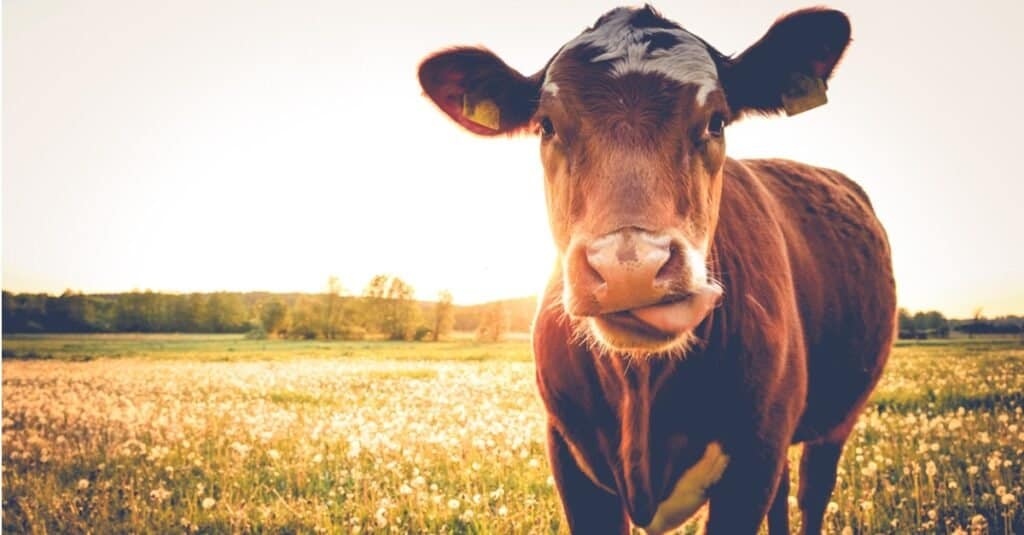How Many Stomachs Does a Cow Have
How Many Stomachs Does a Cow Have
How Many Stomachs Does A Cow Have (And Why?)
Updated: September 17, 2021
Cows are ruminators, that is, they spend much of their time grazing and chewing cud. Simply how is all that chewing plenty to break downward grass? It turns out it's not, and they have a long procedure to further break down the grass they've chewed into cud. Read on to learn more about how many stomachs a cow has and why.
The parts of a cow's breadbasket
Information technology is common for people to say that cows have four stomachs. In reality, cows accept a multi-compartment breadbasket, which is very different from that of humans. When they take in the grass, information technology goes through the rumen, so the reticulum, the omasum, and finally the abomasum. Allow's have a expect at the functions of the cow'south stomach compartments in more particular.
The beginning part of a cow'southward stomach is the rumen. The rumen has a lot of bacteria in it, and it acts to concur food while the leaner break down the cellulose, or fiber, in the plants the cow has eaten. Simply bacteria can break down cellulose, doing then through the fermentation procedure — similar to how yeast works. At this point, the nutrient isn't digested yet and is only partly broken down.
Unlike the homo stomach, y'all won't detect any tum acid here. If y'all picket a moo-cow grazing, you'll notice it taking in a lot of grass, hay, or other plant matter. Information technology doesn't chew the food like a horse does, but instead chews it just enough to moisten it and so swallows information technology whole. The food kickoff goes into the rumen until information technology's filled up. Because of the bacterial activity going on, the rumen is very warm and the sides feel soft.
Following the rumen is the reticulum. Information technology'southward where the food goes into later the rumen, and it allows the cow to regurgitate the food and start doing what's called "chewing the cud" to break downward the food into smaller pieces. The reticulum has bacteria in it, too. With the cow weighing an boilerplate of ane,400 pounds, it spends six to 8 hours a solar day eating, and so some other v to 8 hours chewing cud.
Subsequently the reticulum is the omasum. When the cow has finished chewing its cud, it swallows the nutrient once again, where it travels on to the omasum. It absorbs water and some nutrients which were already broken down. Advent-wise, it has several thin folds of tissue which get in feel hard.
Finally, there's the abomasum, which is where the food is actually digested. The abomasum is considered to be the "true" tummy for all ruminant animals, akin to the man stomach, different the foregut which is where fermentation takes place. It has bile and stomach acid in it, merely information technology may likewise take some bacteria that the rumen used to break down from the cellulose, and it is likewise digested. Any leftover food passes into the intestines.
In that location are other differences betwixt equus caballus and moo-cow digestion, too. If you lot look at horse and cow manure, the horse manure withal has pieces of grain or grass in it. There are none in the moo-cow manure because the establish matter has been much more broken down and digested.

Why do cows have and then many tummy parts?
The diet of a cow is herbivorous, that is, information technology relies on plant matter. You lot could say its tummy is specialized to be able to fully digest the plant matter. Consider the digestive system of a ruminant herbivore such every bit a cow to a horse, which is a non-ruminant herbivore.
Ruminant herbivores include goats, sheep, bison, buffalo, deer, gazelles, antelopes, and giraffes. All ruminant herbivores have multi-compartmented stomachs with the aforementioned four parts. And dissimilar many other mammals, information technology has a longer minor intestine to farther blot nutrients. Omnivorous and carnivorous animals take smaller small intestines, which are suited for the inclusion and digestion of meat in their diet.
The importance of digestive health for cows
Cows must chew cud for better health and milk production. But to do so, information technology needs to be relaxed and comfortable, unremarkably while lying down. This activity encourages saliva to control the acerbity level of the bacteria.
Not only is it important for farmers to be able to find the cows chewing cud, only they must feed the cows a proper diet with enough cobweb and low moisture, carbohydrates, and acidity. The right level of bacterial acerbity in the foregut allows the bacteria to abound and part well in the rumen. Too low an acidity level and the bacterial growth will slow down and the cow won't be able to digest roughage and absorb the nutrients information technology unremarkably would from chewing cud. Lactic acid builds up and the cow's immune system weakens.
As well, harmful bacteria abound and can suddenly kill the cow. Besides high an acidity level and the rumen will experience erosion. If ulcers develop, bacteria can enter the bloodstream and infect the liver, causing abscesses. As you lot can tell, digestive issues are far more serious and fast-interim in cows and other ruminators than in humans and other mammals.
It is a common saying that cows have multiple stomachs, but non how many or why. The reality is that they take multi-compartmented stomachs divided into iv parts, including a foregut and a "true stomach." Each part serves a unlike function for digesting the grass and other found matter they chew. Such is a major feature of ruminators.
Next Up: Why Do Birds Sing In The Morning?
More from A-Z Animals
How Many Stomachs Does a Cow Have
Posted by: newberryventrout.blogspot.com